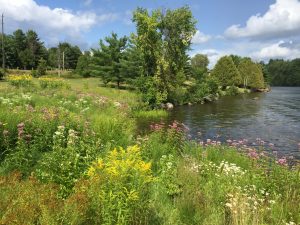by Monica Seidel, Digital Communications and Marketing Intern
Many of our native wildlife populations are declining due to urban development and the removal of natural habitat features. However, there are many ways that landowners can preserve and create habitat on their property so that we can co-exist with these species. Celebrate Earth Day by protecting sensitive shoreline habitats and the wildlife that live there.
In many cases, creating wildlife habitat is as easy as doing nothing! Allowing vegetation to grow naturally to create “no mow” areas, leaving aquatic and terrestrial logs in place, or removing leaf litter are all examples of how you can preserve wildlife habitat by doing nothing.

Create a “No Mow” Zone
Creating a “no mow” zone can be a good way for shoreline landowners to start adding wildlife habitat to their property. Manicured, mowed lawns that are missing natural features like trees, logs, or leaves create a very poor habitat because there is no shelter or food sources available. One exception is Canadian Geese who are known to be attracted to mowed lawns along the water because they prefer open visibility and easy access to spot and escape from predators.
Leave Aquatic Logs
Fallen trees and woody debris that settle along your shoreline, partially or fully in the water, provide crucial habitat for fish, birds, and reptiles like turtles. Fish use woody debris as a shelter from predators, a place to lay their eggs, and to find invertebrates to eat. Turtles need these habitat features to bask in the sun because as reptiles, they receive energy from the sun’s warm temperatures. Waterfowl like ducks and herons use partially emerged logs as resting spots, as well as a place to look for food.
Leave Terrestrial Logs and Leaf Litter

Terrestrial logs, old stumps, fallen branches, woody debris, and leaf litter are essential habitat for small mammals, birds, toads, salamanders, and an abundance of insects. As the log rots, reptiles and amphibians lay their eggs in the moist wood. A decaying log is home to many insects like beetles and ants that burrow under the bark. These insects provide valuable and nutritious food for many other wildlife species. Additionally, these structures provide valuable shelter and protection from predators. In the fall, the leaves that drop off nearby trees add insulation and shelter before the winter as well as adding decaying organic matter and nutrients to the soil.
___
Wildlife like fish, birds, mammals, amphibians, and reptiles are the citizens of the natural world. They maintain the environment through actions like pollination and nutrient cycling while also amazing us with their natural beauty. Using these simple and free methods, you can help protect critical habitat areas and food sources on your property for wildlife for years to come.
To learn more about creating shoreline habitat on your property, visit http://naturaledge.watersheds.ca
